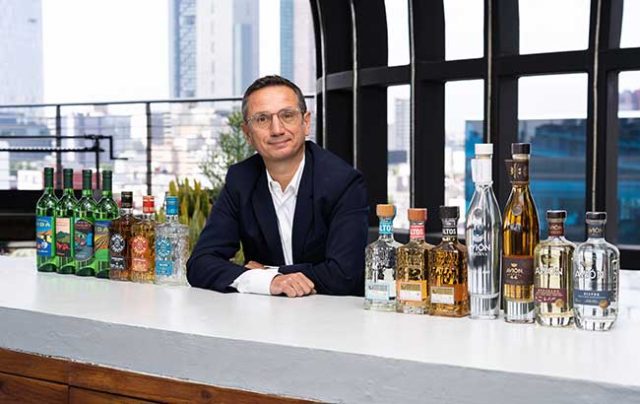SB meets… Michael Merolli, House of Tequila
We caught up with Michael Merolli, CEO of Pernod Ricard’s House of Tequila, to discuss category trends and the spirit it could overtake this year.

Why did you enter the Tequila category?
I’m celebrating 25 years of Pernod Ricard and industry experience this June. I’ve been working all over the world, in many continents and in many categories, but Tequila was the category I needed – I knew the least about it. When I joined House of Tequila in 2020, the Tequila trend was already positive, especially in the US, but it has been accelerating even more since Covid times. As a French native, I had a very clichéd image of Tequila being a shot spirit for high energy. I wanted to understand why Tequila was actually more sophisticated than this.
With Tequila being so popular at the moment, how do you think it can retain this pace?
It’s been one of the fastest-growing categories in the world for maybe the last 10 years – it’s still growing. It’s very dynamic. I’m quite positive and optimistic on the future of Tequila to be honest, because the more people understand the richness, the sophistication, the quality of the category, the more they will enjoy it. While Tequila is already popular in Mexico and in the US, the rest of the world is still to properly discover this category.
We have a very important role to play. And this is really one of my objectives – for the world to understand what quality Tequila is.
Do you think one day it might be overtaken by a different spirit?
Tequila is the one that is overtaking. We were overtaking American whiskey in 2022. We should overtake the vodka category in the US, probably in 2023, which would be a massive achievement. Of course, one other interesting trend is that the mezcal category is growing at a faster pace than Tequila. I don’t think it will overtake Tequila, there’s a lot of good reasons for Tequila to grow. I’m very optimistic for that.
What do you see in the future of Tequila?
The market is becoming more and more sophisticated. There are a lot of players in this market, a lot of new entries, which has created curiosity among consumers about this category. I think, to be honest, that it’s quite crowded at the moment. It’s very difficult for anyone to make a difference.
I think it’s really important that we educate people to make sure they understand the different ranges of Tequila, why prestige Tequila can be highly priced, how it’s made, and what taste profiles can be found.
What advice would you give to a new Tequila company wanting to succeed?
The first thing I would say to someone who wants to enter this market is ‘good luck’, because it’s not going to be easy to make a difference in this market.
One of the things you can really bet on is quality Tequila. Be genuine in what you do, don’t try to imitate. There are brands trying to copy other players. Try to innovate – this is the most difficult. This is what we’re trying to do. We just launched the Altos ready-to-serve Margarita, available as a lime expression and strawberry expression.
The Margarita is having great momentum right now, it’s just an amazing situation. So we have to capitalise on that to leverage it. The ready-to-serve will soon be launched in Australia.
How are brands shaking up the Tequila category?
Altos is a very important brand in House of Tequila’s portfolio. It’s a brand that has been created by bartenders for bartenders. Since the beginning, we’ve been really building a very close relationship with the bartender community. We have a very interesting initiative called the Tahona Society. House of Tequila has worked with bartenders to develop this project. It involves an international cocktail competition, which will happen at the end of June and is centred around sustainability.
What has changed lately in the category?
Many things have happened, I’ve been in this position for almost three years so I’ve been experiencing some of them. Of course there has been the huge demand, and the scarcity of agave. Blue agave is a key ingredient, and this has created a lot of tension, in terms of obtaining the agave, and at what price you can get it.
This isn’t very recent – it started four to five years ago. We’ve become less dependent on the market, a lot of people have started planting a lot of agave many years ago. We’re looking at a better situation with agave.
Also, a lot of the world, in particular Europe, associate Tequila with high-energy moments, with people not paying attention so much to the quality of the Tequila because they drink it as a shot. It’s been changing, thanks to the strong work that the Tequila industry has been doing.
Now people understand that Tequila is a really sophisticated category like whisky or Cognac. People sip it, and indulge themselves with Tequila. We’ve been experiencing premiumisation, and there’s a lot of potential still to grow. It’s clear in the US it is not seen as a brown shot. But in Europe and Asia, we’re looking to educate consumers. There is a growing interest for the Mexican culture, which is becoming more and more trendy.
Do you think celebrity involvement will continue?
Some of them have had high success, of course, but some less success. I think I’m seeing that very positively. It helps raise interest in Tequila not as a spirit but as a lifestyle. People tend to imitate what the big celebrities will drink or do. I’m not sure this is going to continue because the space is very crowded, and only some are going to be successful. I think there are people who have been disappointed by the impact of the celebrity.
Related news
Top 10 spirits launches in June
